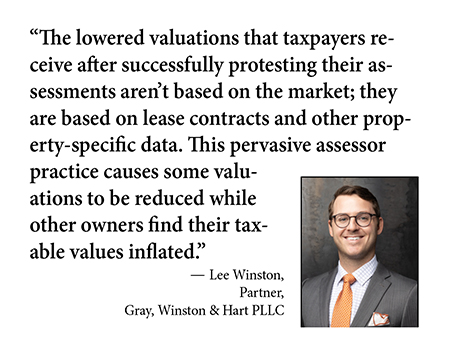By Lee Winston, partner at Gray, Winston & Hart PLLC
No income tax in Texas. The Texas Constitution prohibits it, so local funding depends primarily on property taxes.
But to many Texas businesses, this “necessary evil” has become just plain evil. Over the last several years, property taxes in Texas have exploded.
State politicians have taken notice and are ramping up demands to reduce or eliminate property taxes, but the alternatives are more than unpopular. For instance, nobody wants to pay — and no politician wants to stand for election on — instituting a near 20 percent sales tax. And everyone knows this.

Gray, Winston & Hart PLLC
To avoid this reality, lawmakers have pivoted to find a villain, and the appraisal districts that place the taxable value on property are a ready target.
The popular solutions to rein in this villain are appraisal caps, increased exemptions and value limitations, all of which offer relief to residential property owners but do little for commercial owners. And these “fixes” result in a system that is neither equal nor uniform, undermining the constitutional foundation of taxation in Texas.
Our elected officials have yet to address the fundamental issue driving the over-valuation of most commercial properties, which is appraisal districts’ methodologies. Instead of focusing on each appraisal district’s valuation culture and policies, our elected officials have legislatively restricted appraisal districts from increasing property valuations by more than 20 percent per year. But this limit applies only if the prior-year value is under $5 million.
This isn’t meaningful. It addresses a symptom that has inflamed small business’ opinion of property taxes but does not address the root cause of exploding property taxes.
The root cause of exploding property taxes in Texas is exploding commercial property valuations, the direct result of appraisal districts’ failure to appraise property at its fee simple market value.
Leased-Fee Valuations
For most businesses, real property is income-producing and often leased. The thing about leases is that they split the real property subject to the lease into two interests: the landlord’s leased-fee interest and the tenant’s leasehold interest. Texas appraisal districts appear to operate under the assumption that the sum of these two interests equals the value of real property. They don’t, and that is a problem.
Texas appraisal districts typically value income-producing property using the income approach, and in their analysis, they assume the property is at stabilized occupancy. This is a leased-fee valuation (landlord’s interest plus tenant’s interest), while the Texas Property Tax Code mandates that all real property should be valued at fee simple.
To perform a fee simple valuation, the appraisal districts should be valuing the property in question as though it is vacant and available to be leased at market terms, as set out in The Appraisal of Real Estate, 15th Edition. This approach will result in central appraisal districts properly performing their income-approach valuations by using a lease-up adjustment to stabilized occupancy. The result would be more accurate appraisals as well as equal and uniform valuation of commercial properties.
Without approaching property as vacant and available to be leased at market terms, appraisal districts overstate and unequally treat real property due to a host of intangible factors outside the value of the tangible real property. Examples of intangible value, which isn’t subject to property taxation, include creditworthiness of tenants, superior management, assembled workforce and brand recognition, among others.
As an example of this practice, each year, Texas requires appraisal districts to value real property located in their jurisdictions. For income-producing properties, appraisal districts will estimate and capitalize each property’s net operating income without any lease-up adjustment. Many owners will then protest the appraisal district’s estimations and will ultimately obtain a value reduction because their revenue and expense statements reflect a net income that is lower than what the assessor estimated.
This behavior does not comport with fee simple valuation and has and will continue to create disparities between income-producing properties based on factors other than fair market value of the tangible real estate. This creates unfair competitive advantages for some properties over others.
How so? The lowered valuations that taxpayers receive after successfully protesting their assessments aren’t based on the market; they are based on lease contracts and other property-specific data, from rents to expenses, vacancy rates, brand values and other factors.
This pervasive assessor practice causes some valuations to be reduced while other owners find their taxable values inflated, with taxpayers being punished for the income stream associated with their business rather than the fee simple value of their real property.
This creates an environment where the appraisal districts issue “come and see me” valuations for properties year after year. And then appraisal districts only agree to reduce the assessment once the property owner has provided their confidential leases, revenue, expenses, tenant improvements and net income.
What Can Owners Do?
Until the legislature steps in to address this unfair valuation methodology, Texas property owners do have options.
First, do not be the first commercial real estate owner to have your protest considered. Unfortunately, the longer it takes for a protest to be considered, the better. Wait for those eager businesses with poor occupancy, low rents and high expenses to produce their financials. Appraisal districts, aside from their
leased-fee valuations, are limited in resources and information. So, the more financial information flows in, the more reviewers’ perspective will adjust from their initial estimates to the lower valuation levels protesting taxpayers seek.
Second, and most importantly, invoke equal and uniform valuation. In Texas, all property must be equally and uniformly valued in addition to being valued at market value. To be equally and uniformly valued, a property must be valued equal to the median value of a reasonable number of comparable properties appropriately adjusted. In practice, this means a property should be treated the same as neighboring properties and competitors. So, point to similar properties that the appraisal district is valuing at a more favorable price per square foot than the subject property.
If these options don’t work, pursue an appeal to district court. Armed with a true expert appraisal that focuses on the differences between fee simple versus leased-fee valuation, the taxpayer will have a powerful basis for reducing his or her property’s assessment and, ultimately, the property tax burden.
Lee Winston is a partner at Gray, Winston & Hart PLLC, the Texas member of American Property Tax Counsel, the national affiliation of property tax attorneys. Contact him at lee@graywinston.com.


